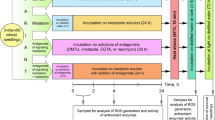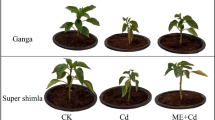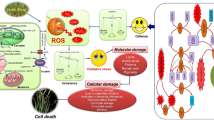Abstract
Lipid peroxidation was examined in Phaseolus coccineus plants treated with 25 μM Cadmium (Cd) for 12 days at two different growth stages of the primary leaves. In the leaves of Cd-treated young plants, the content of free fatty acids was higher only after 8 days of plant exposure to the metal, lipoxygenase activity at pH 7.0 was enhanced after 6 and 8 days of Cd action, but at pH 8.0 it was higher than control, especially after 8 days. Non-enzymatic lipid peroxidation was higher after 6 days of young plant exposure to the metal, but after 8 days it slightly decreased. Glutathione-S-transferase activity decreased during 12 days of the metal action but it was always higher than in control. Anthocyanin content in these plants was also elevated in comparison with control. In Cd-treated older plants, the level of free fatty acids was always higher as compared to control. Lipoxygenase activity at pH 7.0 was lower after 4 days of plant exposure to the metal, but then it was close to control. The enzyme activity at pH 8.0 and the level of lipid peroxidation were lower during 12 days of Cd action in comparison with control. Glutathione-S-transferase activity and anthocyanin pigment content were higher in older Cd-treated plants than in control. Relationships between the pool of free fatty acids, a low level of lipid peroxidation, and glutathione-S-transferase activity in the primary leaves of Cd-treated Phaseolus coccineus plants are discussed. In these plants, lipid peroxidation is under the strict control of metabolism and the antioxidative system works efficiently.


Similar content being viewed by others
References
Ålin P, Danielson H, Mannervik B (1985) 4-Hydroxyalk-2-enals are substrates for glutathione transferase. FEBS 179:267–270
Alscher RG, Donahue JL, Cramer CL (1997) Reactive oxygen species and antioxidants: Relationships in green cells. Physiol Plant 100:224–233
Anderson JA (1995) Lipid peroxidation and plant tissue disorders: introduction to the workshop. HortScience 30:196–197
Barceló J, Vázquez MD, Poschenrieder Ch (1988) Structural and ultrastructural disorders in cadmium-treated bush bean plants (Phaseolus vulgaris L.) New Phytol 108:37–49
Barclay KD, McKersie BD 1994. Peroxidation reactions in plant membranes: Effects of free fatty acids. Lipids 29:877–882
Bartosz G (1997) Oxidative stress in plants. Acta Physiol Plant 19:47–64
Bette A, Kutschera U (1996) Pigment accumulation and photosynthesis in developing rye coleoptiles. Bot Acta 109:194–198
Bradford M (1976) A rapid and sensitive method for the quantitation of microgram quantities of protein utilizing the principle of protein-dye binding. Anal Biochem 72:248–254
Chaoui A, Mazhoudi S, Ghorbal MH, El Ferjani E (1997) Cadmium and zinc induction of lipid peroxidation and effects on antioxidant enzyme activities in bean (Phaseolus vulgaris L). Plant Sci 127:139–147
Das P, Samantaray S, Rout GR (1997) Studies on cadmium toxicity in plants: a review. Environ Pollut 98:29–36
Dhindsa RS, Plumb-Dhindsa P, Thorpe TA (1981) Leaf senescence: correlation with increased levels of membrane permeability and lipid peroxidation, and decreased levels of superoxide dismutase and catalase. J Exp Bot 32:96–101
Dixit V, Pandey V, Shyam R (2001) Differential antioxidative responses to cadmium in roots and leaves of pea (Pisum sativum L. cv.Azad). J Exp Bot 52:1101–1108
Dixon RA, Steele ChL (1999) Flavonoids and isoflavonoids: a gold mine for metabolic engineering. Trends Plant Sci 4:394–400
Duthie G, Crozier A (2000) Plant-derived phenolic antioxidants. Curr Opin Lipid 11:43–47
Edwards R, Dixon DP, Walbot V (2000) Plant glutathione S-transferases: enzymes with multiple functions in sickness and in health. Trends Plant Sci 5:193–198
Feussner I, Wasternack C (2002) The lipoxygenase pathway. Ann Rev Plant Biol 53:275–297
Feussner I, Kuhn H, Wasternack C (2001) Lipoxygenase-dependent degradation of storage lipids. Trends Plant Sci 6:268–273
Fuhrer J (1982) Ethylene biosynthesis and cadmium toxicity in leaf tissue of beans (Phaseolus vulgaris L.) Plant Physiol 70:162–167
Fuller MA, Weichert H, Fischer AM, Feussner I, Grimes HD (2001) Activity of soybean lipoxygenase isoforms against esterified fatty acid indicates functional specificity. Arch Biochem Biophys 388:146–154
Gallego SM, Benavides MP, Tomaro ML (1996) Effect of heavy metal ion excess on sunflower leaves; evidence for involvement of oxidative stress. Plant Sci 121:151–159
Gardner HW (1995) Biological roles and biochemistry of the lipoxygenase pathway. HortScience 30:197–204
Gemel J, Kaniuga Z (1987) Comparison of galactolipase activity and free fatty acid level in chloroplasts of chill-sensitive and chill-resistant plants. Eur J Biochem 166:229–233
Groppa MD, Tomaro ML, Benavides MP (2001) Polyamines as protectors against cadmium or copper-induced oxidative damage in sunflower leaf discs. Plant Sci 161:481–488
Iannelli MA, Pietrini F, Fiore L, Petrilli L, Massacci A (2002) Antioxidant response to cadmium in Phragmites australis plants. Plant Physiol Biochem 40:977–982
Kappus H (1985) Lipid peroxidation: mechanism, analysis, enzymology and biological relevance. In: Sies H (ed.) Oxidative stress. Academic Press, London, pp 273–310
Krupa Z, Baranowska M, Orzeł D (1996) Can anthocyanins be considered as heavy metal stress indicator in higher plants? Acta Physiol Plant 18:147–151
Lange H, Shropshire W, Mohr H (1971) An analysis of phytochrome-mediated anthocyanin synthesis. Plant Physiol 47:649–655
Loeffler Ch, Berger S, Guy A, Durand T, Bringmann G, Dreyer M, van Rad U, Durner J, Mueller MJ (2005) Β1-Phytoprostanes trigger plant defense and detoxification responses. Plant Physiol 137:328–340
Mannervik B, Guthenberg C (1981) Glutathione transferase. Methods Enzymol 77:231–235
Milosevic N, Slusarenko AJ (1996) Active oxygen metabolism and lignification in the hypersensitive response in bean. Physiol Mol Plant Pathol 49:148–158
Niewiadomska E, Miszalski Z (1997) Determination of some oxidative stress parameters in variegated leaves of Chlorophytum comosum (Thunb) Bak. Acta Physiol Plant 19:33–40
Ouariti O, Boussama N, Zarrouk M, Cherif A, Ghorbal MH (1997) Cadmium- and copper-induced changes in tomato membrane lipids. Phytochemistry 45:1343–1350
Percival MP, Williams WP, Chapman D, Quinn PJ (1980) Loss of Hill activity in isolated chloroplasts is not directly related to the free fatty acid release during aging. Plant Sci Lett 19:47–54
Rangel Z, Kordan HA (1987) Effect of growth regulators on light-dependent anthocyanins production in Zea mays seedlings. Physiol Plant 69:511–516
Rice-Evans C, Miller NJ, Papanga G (1997) Antioxidant properties of phenolic compounds. Trends Plant Sci 2:152–158
Romero-Puertas MC, Palma JM, Gómez M, del Rio LA, Sandalio LM (2002) Cadmium causes the oxidative modification of proteins in pea plants. Plant Cell Environ 25:677–686
Sączyńska V (1994) Characteristics of releasing fatty acids from chloroplast membranes lipids of chilling-sensitive and chilling-resistance plants. Doctoral dissertation, Warsaw University, Warsaw (in Polish)
Sanita di Toppi L, Gabbrielli R (1999). Response to cadmium in higher plants. Environ Exp Bot 41:105–130
Scandalios JG (1993) Oxygen stress and superoxide dismutases. Plant Physiol 101:7–12
Schützendübel A, Polle A (2002) Plant responses to abiotic stresses: heavy metal-induced oxidative stress and protection by mycorrhization. J Exp Bot 53:1351–1365
Shah K, Kumar RG, Verma S, Dubey RS (2001) Effect of cadmium on lipid peroxidation, superoxide anion generation and activities of antioxidant enzymes in growing rice seedlings. Plant Sci 161:1135–1144
Shewfelt RL, Purvis AC (1995) Toward a comprehensive model for lipid peroxidation in plant tissue disorders. HortScience 30:213–218
Skórzyńska E, Urbanik-Sypniewska T, Russa R, Baszyński T (1991) Galactolipase activity in Cd-treated runner bean plants. J Plant Physiol 138:454–459
Skórzyńska-Polit E, Baszyński T (1997) Differences in the sensitivity of the photosynthetic apparatus in Cd-stressed runner bean plants in relation to their age. Plant Sci 129:21–28
Skórzyńska-Polit E, Krupa Z (2003) Activity of lipoxygenase in Arabidopsis thaliana – a preliminary study. Cell Mol Biol Lett 8:279–284
Skórzyńska-Polit E, Tukendorf A, Selstam E, Baszyński T (1998) Calcium modifies Cd effect on runner bean plants. Environ Exp Bot 40:275–286
Skórzyńska-Polit E, Pawlikowska-Pawlęga B, Szczuka E, Plak A, Melke J (2005) Localization and activity of lipoxygenase in Cd-treated seedlings of Phaseolus coccineus. Acta Soc Bot Polon 2:199–207
Somashekaraiah BV, Padmaja K, Prasad ARK (1992) Phytotoxicity of cadmium ions on germinating seedlings of mung bean (Phaseolus vulgaris): Involvement of lipid peroxides in chlorophyll degradation. Physiol Plant 85:85–89
Spiteller G (2003) The relationship between changes in the cell wall, lipid peroxidation, proliferation, senescence and cell death. Physiol Plant 119:5–18
Tsuda T, Shiga K, Ohshima K, Kawakishi S, Osawa T (1996) Inhibition of lipid peroxidation and the active oxygen radical scavenging effect of anthocyanin pigments isolated from Phaseolus vulgaris L. Biochem Pharmacol 52:1033–1039
Tukendorf A, Skórzyńska-Polit E, Baszyński T (1997) Homophytochelatin accumulation in Cd-treated runner bean plants is related to their growth stage. Plant Sci 129:21–28
Uchida K (2003) 4-Hydroxy-2-nonenal: a product and mediator of oxidative stress. Prog Lipid Res 42:318–343
Verma S, Dubey RS (2003) Lead toxicity induces lipid peroxidation and alters the activities of antioxidant enzymes in growing rice plants. Plant Sci 164:645–655
Wonisch W, Schaur RJ (2001) Chemistry of glutathione. In Grill P, Tausz M, De Kok LJ (eds). Significance of glutathione to plant adaptation to the environment. Kluwer Academic Publishers, Dordrecht, Boston, London, pp 13–26
Acknowledgments
We are very much obliged to Dr. Eva Selstam for her help with the GC analysis.
Author information
Authors and Affiliations
Corresponding author
Rights and permissions
About this article
Cite this article
Skórzyńska-Polit, E., Krupa, Z. Lipid Peroxidation in Cadmium-Treated Phaseolus coccineus Plants. Arch Environ Contam Toxicol 50, 482–487 (2006). https://doi.org/10.1007/s00244-005-0125-5
Received:
Accepted:
Published:
Issue Date:
DOI: https://doi.org/10.1007/s00244-005-0125-5




